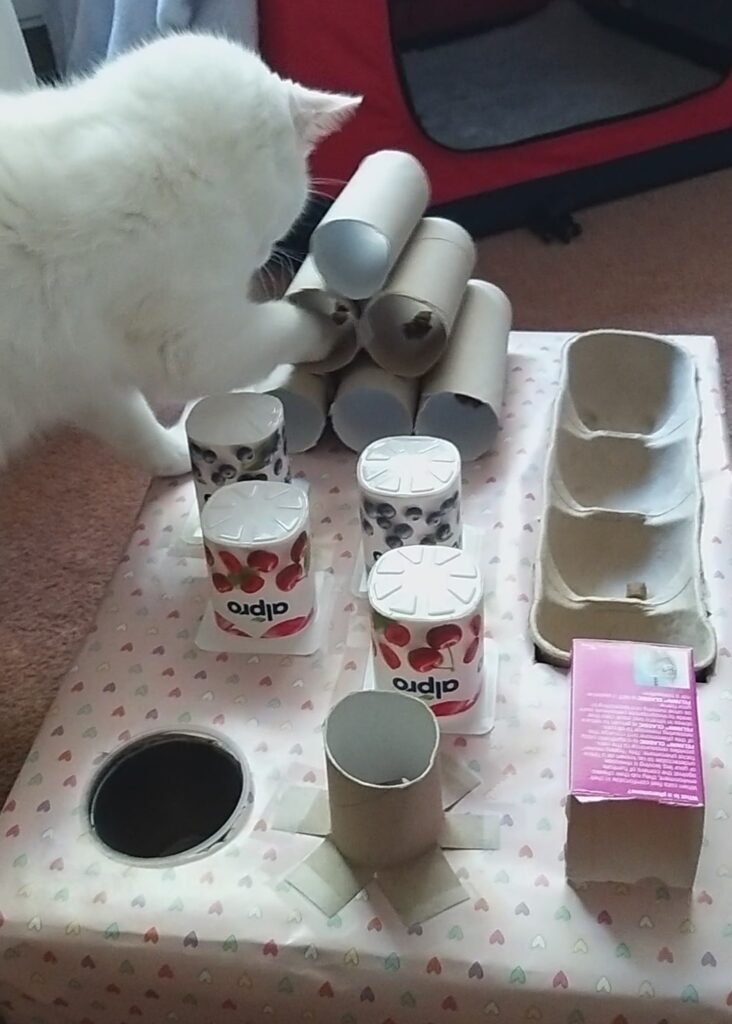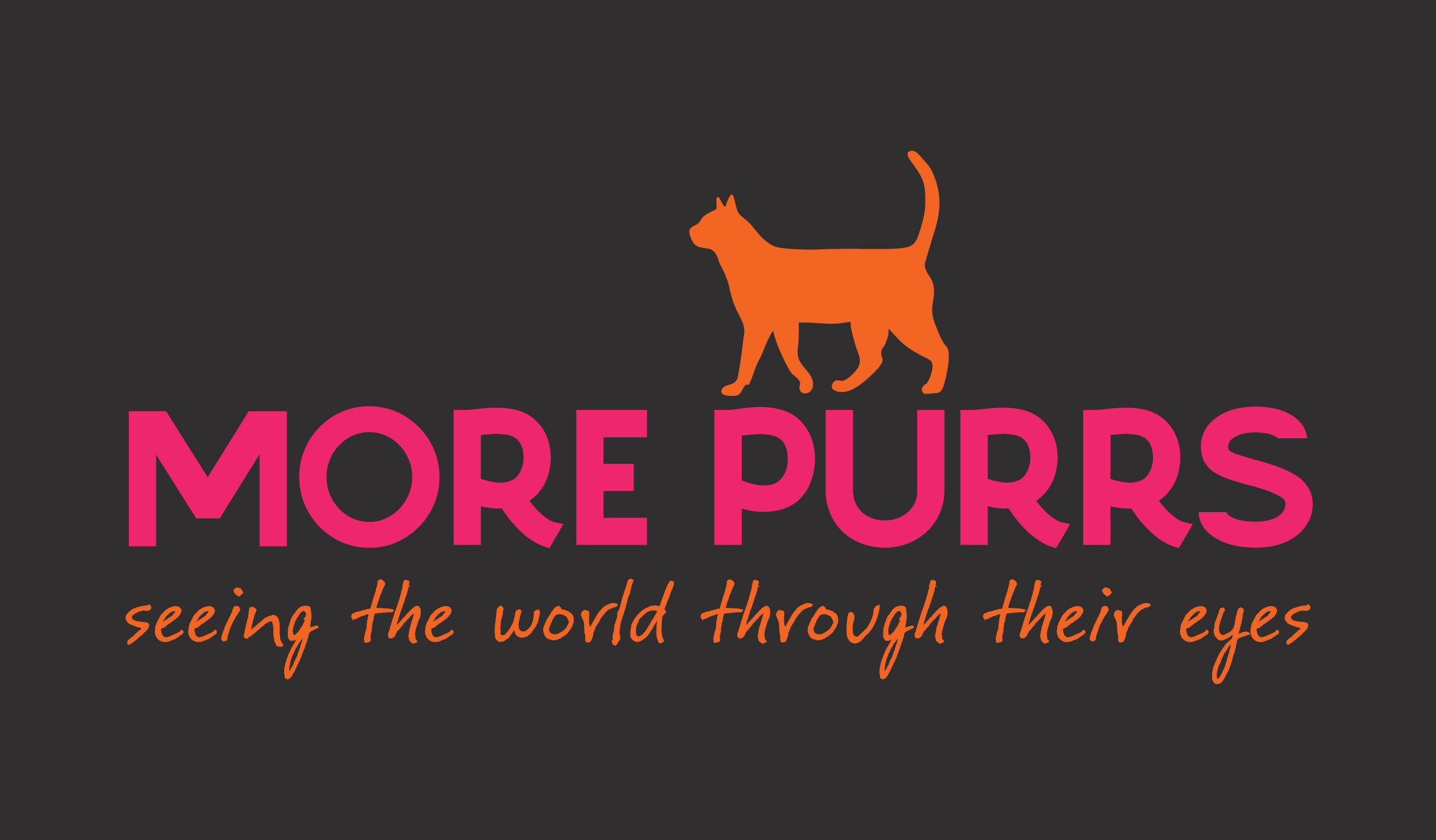When I first discovered puzzle feeding for cats I was fascinated: it made perfect sense! Why had I never thought of this before?
Years before, in a Christmas stocking, 2Sox got a puzzle ball – a small plastic ball with little holes in to dispense biscuits when rolled around. She quickly developed a strategy for rolling the ball and tracing its path, vacuuming up the treats as she went! Despite seeing how much pleasure she got from this, puzzle feeding still didn’t occur to me!

Bowls are boring!
Throughout years of domestication, cats have become accustomed to being fed in bowls/saucers, usually twice a day. As native hunters however, this couldn’t be further from a cat’s natural eating pattern.
Prior to domestication, cats hunted for survival – as feral and some unowned cats still do. As independent hunters, cats are often most successful in catching small prey, such as mice and birds. For these cats to consume enough calories and nutrition, they need to catch at least 10 small rodents EVERY DAY! Such a challenge relies on the cat’s physical health, shrewd observation and top-notch problem-solving skills! This explains why many domestic cats prefer to eat little and often, usually revisiting their food bowls throughout the day, eating small amounts each time (or demanding a fresh top up!).
Although today’s domestic cats don’t need to worry about where their next meal is coming from, they do still have a natural instinct to hunt. Unlike feral/unowned cats who hunt to survive, domestic cats don’t always consume their prey (most probably because their tummies are already full!). This is often distressing for owners who see their cat playing with and tormenting their prey, or proudly depositing it on the kitchen floor! On the other hand, many indoor cats don’t have the opportunity to hunt, and may show signs of frustration and/or boredom if their environment lacks stimulation.
Benefits of puzzle feeders for cats
Puzzle feeding is a superb way of awakening your cat’s natural senses and giving them the opportunity to exercise their inherent problem-solving skills. Novelty, and the motivation to obtain food, is a great way to keep your cat’s mind and body healthy – regardless of their age.
A vast number of domestic cats in the UK are reported to be overweight, which can cause a variety of serious health problems. Cats may become overweight through lack of exercise and/or over-eating, both of which can be a direct result of boredom or frustration – both of which may also manifest in aggression or other undesirable behaviours.
Indoor cats may be more prone to these risks if their environment isn’t sufficiently stimulating. Please note, this is not true for all indoor cats – many have wonderful environments that have taken account of their essential needs and provide plenty of stimulation. Equally, some outdoor cats may lack excitement, depending on various stressors in their environment. Learn more about how a cat’s home environment influences their feelings and emotions.
Puzzle feeding encourages cats to become more active, to practice their innate problem-solving skills, and to eat more slowly than they would from a bowl. Cats who regularly eat from puzzle feeders are likely to benefit emotionally through increased mental stimulation, as well as losing weight by becoming more active.

What are Puzzle Feeders?
Puzzles can be all shapes and sizes. The idea is that your cat uses their skills and natural senses to retrieve the food – this includes using their paws, noses, tongues, mouths and instinct.
Puzzles should be challenging, but not difficult to the extent where the cat feels frustrated. You can start off with simple puzzles and then increase the complexity as they get the hang of it. To maintain interest, it is advisable to vary puzzles so that the concept remains novel (this is one reason why homemade puzzles are so great!) You can find some examples of homemade puzzles at the end of this article (and plenty more online). Making your own puzzles is really affordable as you can save up a collection of empty tubs, pots, tubes, boxes, jars etc. It’s a great idea to get children involved in designing puzzles too and encourages them to learn about cats at the same time.
Caution: If you are making a puzzle feeder do not use glue (you don’t want to poison your cat!) also, be careful to ensure that nothing has any sharp edges.
Novelty is very appealing to cats and they are likely to become disinterested in the same puzzle after a while. This is another reason why homemade puzzles are great – you can recycle the used puzzle and create a brand new one! Alternatively, make a few variations and swap them every so often.
I don’t think my cat will be interested…
I’ve heard this lots of times but, trust me, you will be surprised! Although some cats may need encouragement to start with, puzzle feeding is recommended for all cats of all ages. If this is something completely new for your cat, it is advisable to introduce a puzzle through play. Perhaps initiate a game (with their favourite toy) when you are with the puzzle, then, drop some of their favourite treats in the puzzle – making sure that some can be reached easily. You might sprinkle a little catnip on the puzzle to spark extra interest! As your cat grasps the concept, you can reduce the number of treats and instead, add their regular food.
Do your best for your cat…
Hopefully, this article has inspired you to think creatively about feeding your cat. My advice is to start small and build up to what you can manage. If you can progress to 100% puzzle feeding that is wonderful, though if you manage to feed 50% of your cat’s food via a puzzle that is great too. Any amount of added stimulation will be better than none at all.
There are some fantastic puzzle feeders available online, just search ‘Cat Puzzle Feeders’ and you’ll find a great variety. Your cat will appreciate a homemade puzzle feeder just as much as one you have purchased, as long as it is safe and suitably challenging. There are advantages & disadvantages of both homemade and purchased puzzle feeders regarding cost, novelty and ease of cleaning. The choice is entirely yours and you may like to experiment with both to see which your cat prefers!
On a final note, make sure that your cat always has plenty of fresh water. It is advisable to have a few bowls in different locations to give your cat a choice (my cat’s love their water bowl on the landing!). Avoid putting water right next to your cat’s food as they would usually consider the area in which food has been eaten to be contaminated (remembering that they would have instinctively killed their prey).
Summary of Puzzle Feeding Benefits
- Stimulate and excite your cat’s natural senses
- Introduce a more natural feeding pattern (you may find that have less waste)
- Prevent boredom (which can sometimes manifest as frustration, over-eating and aggression)
- Provide stimulation for your cat during the night (which may prevent them waking you up!)
- Prevent your cat from eating too fast (which may cause them to be sick)
- Encourage your cat to be more active (which helps in preventing obesity)
For further information, and a more comprehensive review of these benefits and how to introduce puzzle feeding, check out this review by Dr Sarah Ellis and Dr Lizzie Rowe from International Cat Care A report into improving the health and welfare of the UK’s domestic cats
